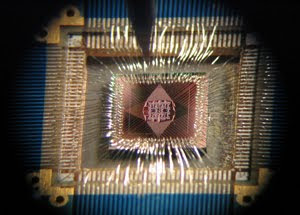Ultrafast Quantum Computers dream comes reality with 10 Billion bits Silicon Chips
iTechWhiz (Feb 11, 2011) - Scientists from Oxford University have made a significant step towards an ultrafast quantum computer by successfully generating 10 billion bits of quantum entanglement in silicon for the first time; entanglement is the key ingredient that promises to make quantum computers far more powerful than conventional computing devices.
The researchers used high magnetic fields and low temperatures to produce entanglement between the electron and the nucleus of an atom of phosphorus embedded in a highly purified silicon crystal. The electron and the nucleus behave as a tiny magnet, or 'spin', each of which can represent a bit of quantum information. Suitably controlled, these spins can interact with each other to be coaxed into an entangled state the most basic state that cannot be mimicked by a conventional computer.
An international team from the UK, Japan, Canada and Germany, report their achievement in the journal Nature.
The work has important implications for integration with existing technology as it uses dopant atoms in silicon, the foundation of the modern computer chip. The procedure was applied in parallel to a vast number of phosphorus atoms. Dr John Morton of Oxford University's Department of Materials who led the team said:
In recent years quantum entanglement has been recognized as a key ingredient in building new technologies that harness quantum properties. Famously described by Einstein as "spooky action at distance" -- when two objects are entangled it is impossible to describe one without also describing the other and the measurement of one object will reveal information about the other object even if they are separated by thousands of miles.
Creating true entanglement involves crossing the barrier between the ordinary uncertainty encountered in our everyday lives and the strange uncertainties of the quantum world. For example, flipping a coin there is a 50% chance that it comes up heads and 50% tails, but we would never imagine the coin could land with both heads and tails facing upwards simultaneously: a quantum object such as the electron spin can do just that.
Dr Morton said:
 |  |
The researchers used high magnetic fields and low temperatures to produce entanglement between the electron and the nucleus of an atom of phosphorus embedded in a highly purified silicon crystal. The electron and the nucleus behave as a tiny magnet, or 'spin', each of which can represent a bit of quantum information. Suitably controlled, these spins can interact with each other to be coaxed into an entangled state the most basic state that cannot be mimicked by a conventional computer.
An international team from the UK, Japan, Canada and Germany, report their achievement in the journal Nature.
"The key to generating entanglement was to first align all the spins by using high magnetic fields and low temperatures,' said Stephanie Simmons of Oxford University's Department of Materials, first author of the report. 'Once this has been achieved, the spins can be made to interact with each other using carefully timed microwave and radiofrequency pulses in order to create the entanglement, and then prove that it has been made."
The work has important implications for integration with existing technology as it uses dopant atoms in silicon, the foundation of the modern computer chip. The procedure was applied in parallel to a vast number of phosphorus atoms. Dr John Morton of Oxford University's Department of Materials who led the team said:
"Creating 10 billion entangled pairs in silicon with high fidelity is an important step forward for us. We now need to deal with the challenge of coupling these pairs together to build a scalable quantum computer in silicon."
In recent years quantum entanglement has been recognized as a key ingredient in building new technologies that harness quantum properties. Famously described by Einstein as "spooky action at distance" -- when two objects are entangled it is impossible to describe one without also describing the other and the measurement of one object will reveal information about the other object even if they are separated by thousands of miles.
Creating true entanglement involves crossing the barrier between the ordinary uncertainty encountered in our everyday lives and the strange uncertainties of the quantum world. For example, flipping a coin there is a 50% chance that it comes up heads and 50% tails, but we would never imagine the coin could land with both heads and tails facing upwards simultaneously: a quantum object such as the electron spin can do just that.
Dr Morton said:
"At high temperatures there is simply a 50/50 mixture of spins pointing in different directions but, under the right conditions, all the spins can be made to point in two opposing directions at the same time. Achieving this was critical to the generation of spin entanglement."











No comments:
Comments which are abusive, offensive, contain profanity, or spam links will be discarded as per our Comments Policy.